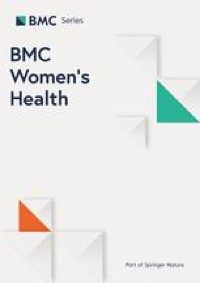
This is a randomized clinical trial of patients with symptomatic submucosal leiomyomas from 2014 to 2017. Oral and written informed consents were obtained from all patients in the study. Amita Saint Francis hospital in Evanston granted full Institutional in 2014 and Saint Joseph Hospital in Chicago granted full Institutional Review Board (IRB) approval in 2015. Periodic review of protocol that research does not involve greater than minimal patient risk was addressed as part of IRB submission approval. All methods were carried out in accordance with relevant guidelines and regulations. The study population includes women aged 18 and older with abnormal uterine bleeding and submucosal fibroids. Patients with Type 0, 1, or 2 submucosal myomas, assessed with a pelvic 2-D ultrasound, were recruited from the private practice of the attending surgeon, and included in the trial. Patients assigned to the medical therapy group includes use of combination oral contraceptive pills or a 52 mg levonorgestrel-releasing intrauterine device. Generic combined oral hormonal contraception of 20 mcg of ethinyl estradiol and norethindrone acetate was commonly prescribed. The surgical treatment group includes hysteroscopic myomectomy using the TruClear™ (Medtronic, Minneapolis, MN) hysteroscopic tissue removal system and procedure was performed in a community hospital setting. There was no endocrine priming done before treatment. Treatment was provided based on shared decision-making and procedure was aligned according to patient’s menstrual period and typically during the follicular phase of the menstrual cycle. The TruClear™ mechanical hysteroscopic tissue removal device used for measures 7.25 mm outer diameter.
Exclusion criteria included pregnancy, suspicion of uterine malignancy, and absence of submucosal leiomyoma(s) seen during planned hysteroscopic myomectomy. The study also excluded patients with active vaginal infection, women with contraindication to hysteroscopic myomectomy, and cognitively impaired patients who could not provide consent and adequately complete the questionnaire.
Patient demographics assessed include age, ethnicity, body mass index (BMI), parity, substance abuse, medical history, surgical history, and preoperative indication(s) for hysteroscopic myomectomy. A random allocation sequence was generated with randomization of the patients to two different assignment groups either medical or surgical treatment, using 1:1 allocation. The randomization scheme was created using a pseudo-random number generator (i.e., the PLAN procedure within the SAS software, version 9.4 (SAS Institute Inc., Cary, NC) and consisted of random permuted blocks, having variable blocks of either size 2 or 4, with a 1:1 allocation to the treatments. Once the patient signed the consent, the patient was randomized into one of the two arms through the drawing of a sealed, opaque envelope.
Patients completed the Uterine Fibroid Symptom and Health-related Quality of Life Questionnaire (UFS-QOL) at enrollment and at 1, 3, and greater than or equal to 6 months after treatment. Patients were asked to complete the UFS-QOL questionnaire form either during a follow-up visit in written format, follow up telephone encounter with recorded answers, mailed survey or online survey. The UFS-QOL questionnaire form has eight subscales measuring Health Related Quality of Life (HR-QOL). Higher scores (increased from baseline) for the subscales including concern, activities, energy/mood, control, self-consciousness, sexual function, and total score indicate improvement in HR-QOL. Lower scores (or decrease from baseline) in HR-QOL symptom severity subscale reflect improvement.
This trial based the sample size estimation on myomectomy patients’ UFS HR-QOL total score data by Spies et al. [17]. A UFS-QOL improvement from baseline to 6 months or more post-treatment of leiomyomas in the treatment arm using medication was anticipated to be similar to that reported by Spies et al. An improvement in UFS-QOL total score of approximately 40 points with a standard deviation of approximately 23 points was projected. We assumed a UFS-QOL improvement from baseline to 6 months or more post-treatment of leiomyomas in the treatment arm using surgical intervention with TruClear™ hysteroscopic tissue removal system to be 60 points. Thus, for sample size estimation of the trial, the expected difference between the two treatment arms was 20 points (i.e., 60 − 40) with a standard deviation of 23 points.
Based on these assumptions, a sample size of 24 patients per group provided 80% statistical power to detect a difference in the change from baseline to 6 months post-medical treatment in the UFS-QOL total scores of 20 points between the two treatment arms using a two-sided test with a significance level of 0.05. Therefore, it was planned to recruit at least 56 subjects for this study with an anticipated 20% dropout rate.
The primary analysis invoked an intent-to-treat paradigm, wherein all randomized subjects were included according to their randomized treatment assignment regardless of actual treatment received. A linear mixed-effects model was used to assess the differences between and within the two treatment arms (i.e., with and without TruClear™ hysteroscopic tissue removal system device) for the primary outcome of UFS-QOL total score. The fixed independent factors for the linear mixed-effects model included the treatment arm (with TruClear™ hysteroscopic tissue removal system device or medical therapy using hormonal contraceptive or levonorgestrel releasing IUD), time (baseline, 1, 3, and greater than or equal to 6 months), and the interaction of treatment and time. The mixed model included a random subject effect and a first order antedependence covariance structure for correlation among time points. From the linear mixed-effects model, comparisons were constructed to test the hypotheses of interest (e.g., change from baseline). The model does not drop subjects with incomplete (i.e., missing at random) data from the analysis. Differences in means and associated 95% confidence intervals (CIs) were used to quantify the effects’ magnitude. Similarly, separate linear mixed-effects models were used for each of the seven, secondary outcome UFS-QOL scores (i.e., concern, activities, energy/mood, control, self-conscious, sexual function, and symptom severity).
Although the sample size estimates considered subject dropout, efforts were made during the study to minimize any patient dropout. Study attrition did not appear to be an issue. All hypothesis tests were two-sided, and all analyses performed using SAS software, version 9.4. This trial is registered at ClinicalTrials.gov with clinical trial registry number NCT02934789, trial registration 17/10/2016, and URL:
https://register.clinicaltrials.gov/prs/app/template/EditRecord.vm?epmode=Edit&uid=U0002EJO&ts=6&sid=S0006MUC&cx=-uiayqz. The data repository set is available online at https://data.mendeley.com/datasets/xykswpsgmy/1.



